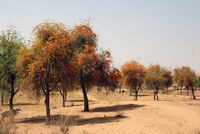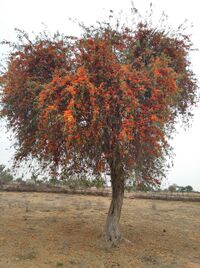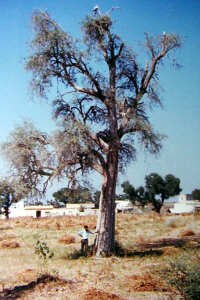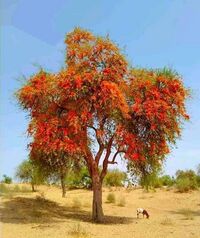Rohida
| Author:Laxman Burdak, IFS (R) |


Rohida (रोहीड़ा) is tree species found in Thar Desert regions of northwest and western India.
Variants of name
- Tecomella undulata (Botanical name)
- Rohira (रोहीड़ा) (Hindi)
- Rohida (रोहीड़ा) (Hindi)
- Rohitaka (रोहीतक) (Sanskrit)
- Rohitika (रोहीतिक) (Sanskrit)
- Haroora ( ہروڑا ) (Pakistan)
Jat connections
- Ruhela,
- Rohtak - The city gets name from abundance of Rohitaka (रोहीतक) trees
- Rohitik (रोहितिक) gotra of Jats get this name after Raja Rohita (रोहित). [1]
Tree characteristics

It is a medium sized tree that produces quality timber and is the main source of timber amongst the indigenous tree species of desert regions of Shekhawati and Marwar in Rajasthan. The trade name of the tree species is Desert teak or Marwar teak. It is a deciduous or nearly evergreen tree of arid and semi arid regions. It occurs on flat and undulating areas including gentle hill slopes and sometimes also in ravines. It is well adapted to drained loamy to sandy loam soil having pH 6.5-8.0. The species thrives very well on stabilized sand dunes, which experience extreme low and high temperatures. It grows in areas of scanty rainfall (annual 150-500mm) and high temperature (35 °C to 48 °C). It can withstand extreme low temperature (0 °C to −2 °C) during winter and high temperature (48 °C to 50 °C) in summers. The tree is a strong light demander. It is drought, frost, fire and wind hardy. At the time of flowering (December-February) it produces beautiful showy flowers in yellow, orange and red colours. Three types of flower bearing trees can be observed near to each other in the same vicinity.
Distribution
Distribution of Tecomella undulata is restricted to the drier parts of the Arabia, southern Pakistan and northwest India up to an elevation of 1200 metres. In Pakistan in Attock kala chita mountain, where its local name is Haroora( ہروڑا ) it is found in Balochistan Musakhel and Khuzdar (Pakistan) (Baluchistan and Sindh. In India, it occurs naturally in Maharashtra, Gujarat, Rajasthan, Punjab and Haryana.The species is mainly found to occur in western parts of Rajasthan. In other states its population is scanty and very rare. In Rajasthan, Tecomella undulata is found in Barmer, Jaisalmer, Jodhpur, Pali, Ajmer, Nagaur, Bikaner, Churu and Sikar districts. Tecomella undulata is an accepted tree species in agro forestry and large population is found in agricultural lands. It can be observed growing in community land, forestland and orans in association with Prosopis cineraria, Capparis decidua, Maytenus emarginata, Zizyphus spp. And Salvadora spp. In agriculture land it generally grows in association with Prosopis cineraria.
Uses
Tecomella undulata is mainly used as a source of timber. Its wood is strong, tough and durable. It takes a fine finish. Heartwood contains quinoid. The wood is excellent for firewood and charcoal. Cattle and goats eat leaves of the tree. Camels, goats and sheep consume flowers and pods.Tecomella undulata plays an important role in ecology. It acts as a soil-binding tree by spreading a network of lateral roots on the top surface of the soil. It acts as a windbreak and helps in stabilizing shifting sand dunes. It is considered as the home of birds and provides shelter for other desert wildlife. Shade of tree crown is shelter for the cattle, goats and sheep during summer days.Tecomella undulata has got medicinal properties as well. The bark obtained from the stem is used as a remedy for syphilis. It is also used in curing urinary disorders, enlargement of spleen, gonorrhoea, leucoderma and liver diseases. Seeds are used against abscess. Traditionally in Musakhel, Pakistan its flower used for Hepatitis.
In Mahabharata
Sabha Parva, Mahabharata/Book II Chapter 29 Mentions Kings whom Nakula subjugated, who set out from Khandavaprastha for the west. He first assailed the mountainous country called Rohitaka (Rohtak) that was dear unto (the celestial generalissimo) Kartikeya
- ततॊ बहुधनं रम्यं गवाश्वधनधान्यवत
- कार्तिकेयस्य दयितं रॊहीतकम उपाद्रवत Mahabharata (II.29.4)
Vana Parva, Mahabharata/Book III Chapter 174 mentions about journey of Pandvas in Dwaitavana , where the see The holy fig, the rudaraksha, the rohitaka, the cane and the jujube, the catechu, the sirisha, the bel and the inguda and the karira and pilu and sami trees grew on the banks of the Saraswati. Wandering about with contentment in (the vicinity of) the Saraswati which was, as it were, the home of the celestials, and the favourite (resort) of Yakshas and Gandharvas and Maharshis, those sons of kings lived there in happiness.
- समीक्ष्य तान दैतवने निविष्टान; निवासिनस तत्र ततॊ ऽभिजग्मुः
- तपॊ थमाचार समाधियुक्तास; तृणॊथ पात्राहरणाश्म कुट्टाः (Mahabharata:3.174.22)
- पलक्षाक्ष रौहीतक वेतसाश च; सनुहा बथर्यः खथिराः शिरीषाः
- बिल्वेङ्गुथाः पीलु शमी करीराः; सरस्वती तीररुहा बभूवुः (Mahabharata:3.174.23)
Udyoga Parva/Mahabharata Book V Chapter 19 mentions about the army of the Kauravas: ....And, O descendant of Bharata, there was no space in the city of Hastinapura even for the principal leaders of Duryodhana's army. And for this reason the land of the five rivers, and the whole of the region called Kuru-jangala, and the forest of Rohitaka which was uniformly wild, and Ahichhatra and Kalakuta, and the banks of the Ganga, and Varana, and Vatadhana, and the hill tracts on the border of the Yamuna--the whole of this extensive tract--full of abundant corn and wealth, was entirely overspread with the army of the Kauravas. And that army, so arranged, was beheld by the priest who had been sent by the king of the Panchalas to the Kurus.'"
- न हास्तिनपुरे राजन्न अवकाशॊ ऽभवत तथा
- राज्ञां सबलमुख्यानां पराधान्येनापि भारत (Mahabharata:V.19.28)
- ततः पञ्चनदं चैव कृत्स्नं च कुरुजाङ्गलम
- तदा रॊहित कारण्यं मरु भूमिश च केवला (Mahabharata:V.19.29)
रोहिड़ा - एक अनुपम वृक्ष

- नैण न झपकै निरखतां, उर में जगै उमंग|
- मन-आंगण महकावणा, रंग रोहिड़ा रंग||
मरुभूमि का सागवान कहा जाने वाला रोहिड़ा वृक्ष अंधाधुंध कटाई के चलते अस्तित्व की लड़ाई लड़ रहा है। एक तरफ सरकार पर्यावरण संरक्षण के नाम पर कई योजनाएं चला रही है, वहीं दिनों दिन राज्य पुष्प रोहिड़ा के कट रहे वृक्षों को बचाने की दिशा में कोई कदम नहीं उठा रही। कुछ वर्षों पहले राजस्थान में रोहिड़ा की बहार थी। वर्षों से रोहिड़ा मरुभूमि की शान रहा है। समय के साथ आधुनिकता पसरती गई और रोहिड़ा के वृक्ष कटते गए। हालत यह है कि वर्तमान में यह मुश्किल से दिखाई देने लगा है। रेतीले खेतों में रोहिड़ा के पेड़ खुशहाली का संदेश देते हैं। इनकी खुशबू दूर-दूर तक महकती है। अंचल में इस पेड़ पर फूलों का खिलना समृद्धि का सूचक माना जाता है। साहित्य में मरुशोभा की उपाधि वाले इस वृक्ष की लकड़ी का फर्नीचर काफी मजबूत और टिकाऊ होता है। इसलिए इसे देशी सागवान भी कहा जाता है। रोहिड़ा के फूल को 21 अक्टूबर 1983 को राजस्थान सरकार ने राज्य पुष्प घोषित किया था। इसके लिए प्रख्यात राजस्थानी कवि मुरलीमनोहर बासोतिया लिखते हैं -
- रोही को राजा रोहीड़ो, चटकीलै रंग फूल।
- मस्त करै मिंजर की सौरम, लुळै नीमड़ा झूल।
पिछले दो दशक में रोहिड़े के वृक्ष के निरंतर कटने से अब यह मुश्किल से दिखाई देता है। एक समय था जब मरुभूमि में रोहिड़ा बहुतायत में था, लेकिन अब इनकी संख्या सिमट गई है। वैसे भी राजस्थान में रोहिड़ा के पेड़ राष्ट्रीय औसत से कम हैं। रोहिड़ा की बेहिसाब कटाई से क्षेत्र का संतुलन गड़बड़ा गया है। राजस्थान का सागवान माना जाने वाला रोहिड़ा का पेड़ औसतन 25 फीट तक ऊंचा होता है। वर्ष 1983 में राज्य पुष्प का दर्जा मिलने के बाद जहां इसका विस्तार होना चाहिए था, वहीं यह लुप्त होने लगा है। ऐसा नहीं है कि इसे तैयार करना मुश्किल है या मांग नहीं है। राज्य पुष्प का दर्जा प्राप्त रोहिड़ा की खूबसूरती की बेकद्री हो रही है। रोहिड़ा पेड़ की लकड़ी 100 वर्षो तक खराब नहीं होती, ऐसी में इस लकड़ी की मांग सबसे ज्यादा रहती है, वहीं यह एक पेड़ 15 हजार रुपये तक बिकता है। इस लकड़ी का फर्नीचर दरवाजे सहित कई कामों में उपयोग होता है लेकिन इसे चोरी छुपे काटा जा रहा है।
रोहिड़ा बिगोनिएसी परिवार के टेकोमेला वंश का वृक्ष है। इसे रोहिरा, रोही, रोहिटका आदि नामों से भी जाना जाता है। इसका वैज्ञानिक नाम टेकोमेला अनडयूलाटा है। अंग्रेजी में इसे रोहिरा ट्री और हनी ट्री कहते हैं। रोहिड़ा अरब देशों में भी पाया जाता है। यहां यह वृक्ष शजरत-अल-असल के नाम से प्रसिद्ध है। यह शुष्क क्षेत्रों और बाहरी हिमालय का एक महत्वपूर्ण एवं उपयोगी वृक्ष है। यह भारत के साथ ही पाकिस्तान और अरब देशों में भी पाया जाता है। पाकिस्तान में सिंध और बलूचिस्तान में इसकी संख्या अधिक है। भारत में इसे सागर की सतह से 1200 मीटर तक ऊंचाई वाले शुष्क भागों में देखा जा सकता है। भारत में यह मूल रूप से राजस्थान, महाराष्ट्र, गुजरात, पंजाब और हरियाणा में मिलता है। भारत के उत्तर-पूर्व में और पश्चिम भारत के थार के रेगिस्तानी क्षेत्रों में रोहिड़ा को प्रकृति का एक अनुपम वरदान समझा जाता है। यह राजस्थान के पश्चिमी क्षेत्र के लोगों के जीवन में बहुत महत्वपूर्ण स्थान रखता है। इस क्षेत्र में इसकी संख्या बहुत अधिक है। राजस्थान में यह जैसलमेर, जोधपुर, पाली, अजमेर, नागौर, बीकानेर, चूरू, झुंझुनू, सीकर आदि जिलों में बहुत बड़ी संख्या में मिलता है।
शुष्क और अर्धशुष्क क्षेत्रों का पतझड़ वाला वृक्ष है रोहिड़ा, किन्तु इस पर वर्ष के अधिकांश महीनों में पत्तियां रहती हैं तथा ऐसा बहुत कम समय होता है जब यह पूरी तरह पत्तियों से रहित हो जाता है। अत: इसे लगभग सदाबहार वृक्ष अथवा अर्ध-सदाबहार वृक्ष कहा जा सकता है। मध्य आकार का यह वृक्ष समतल मैदानों, पहाड़ी दलानों तथा घाटियों में उत्पन्न होता है। इसे उपजाऊ भूमि पर तथा खेतों के मध्य भी उगाया जा सकता है। रोहिड़ा की एक महत्वपूर्ण विशेषता यह है कि इसे रेत के स्थायी टीलों पर, जहां तापमान बहुत कम और बहुत अधिक हो, सरलता से उगाया जा सकता है।
रोहिड़ा रेतीली मिट्टी में उगने वाला वृक्ष है। इसमें सूखा सहन करने की विलक्षण क्षमता होती है। यह कम वर्षा वाले क्षेत्रों में भी उगता है और अपना विकास करता है। यह ज्ञात हुआ है कि यह 150 मिली मीटर से लेकर 500 मिली मीटर तक वर्षा वाले क्षेत्रों में अपना अस्तित्व बनाये रखता है। इसमें तापमान का उतार-चढ़ाव सहन करने की भी अद्भुत क्षमता होती है। यह सर्दियों में शून्य डिग्री सेल्सियस और कभी-कभी शून्य से भी दो डिग्री कम तापमान तक सहन कर लेता है। इसके साथ ही यह गर्मियों के मौसम में 43 डिग्री सेल्सियस तापमान में भी हरा-भरा बना रहता है। राजस्थान के रेगिस्तानी क्षेत्रों में कभी-कभी तापमान 50 डिग्री सेल्सियस तक पहुंच जाता है। ऐसे मौसम में भी रोहिड़ा अपना अस्तित्व बनाए रखता है।
वास्तव में रोहिड़ा के लिए सूरज की गर्मी बहुत आवश्यक होती है। सूरज की तेज गर्मी और प्रकाश में इसका जन्म और विकास होता है। इसकी शाखाएं जमीन की ओर नीचे झुकी हुई होती हैं तथा इन पर छोटी-छोटी पत्तियां लगती हैं। ये पत्तियां लंबी होती हैं तथा इनका आगे का भाग नुकीला होता है। इसकी पत्तियों का ऊपर वाला भाग धूसरपन लिये हुए गहरे हरे रंग का होता है एवं नीचे वाला भाग कुछ हल्के रंग का होता है। रोहिड़ा के फल कुछ मुड़े हुए होते हैं एवं इसके बीज बालदार होते हैं। इन्हीं बालों के कारण यह हवा के साथ उड़कर राजस्थान में दूर-दूर के क्षेत्रों में फैल गया है एवं राजस्थान के बाहर भी उन क्षेत्रों में पहुंच गया है। जहां पर यह नहीं पाया जाता था। रोहिड़ा का फूल बहुत खूबसूरत और शानदार होता है। इस पर सर्दियों के मौसम में फूल आते हैं। इसके फूल पीले, नारंगी और लाल रंग के होते हैं। तथा इसकी आकृति घंटी के समान होती है। सर्दियों के मौसम में रोहिड़ा वृक्ष फूलों से भर जाता है।
मरु भूमि का सागवान कहा जाने वाला रोहिड़ा अस्तित्व की लड़ाई लड़ रहा है। एक तरफ सरकार पर्यावरण संरक्षण के नाम पर कई योजनाएं चला रही है, वहीं दिनों-दिन राज्य पुष्प रोहिड़ा के कट रहे वृक्षों को बचाने की दिशा में कोई कदम नहीं उठाया रही। सालों से वन विभाग की नर्सरियों में इसकी पौध तैयार नहीं कराई जा रही। हर नर्सरी में हजारों पौध हर वर्ष तैयार होती है लेकिन विभागीय अधिकारी रोहिड़ा की पौध तैयार करना भूल जाते हैं। जिसके चलते धीरे धीरे इन पेड़ों की संख्या कम होती जा रही है। यदि समय रहते राज्य पुष्प को सरक्षण नहीं मिला तो वह एक दिन दूर नहीं जब रोहिड़े के पेड़ एवं मनमोहक फूल किताबो में ही पढ़ने को मिलेंगे। रोहिड़ा की गणना उन वृक्षों में की जाती है जो पर्यावरण संतुलन बनाये रखने में महत्वपूर्ण भूमिका निभाते हैं। इसकी जड़ें मिट्टी की ऊपरी सतह पर फैल जाती हैं। इससे मिट्टी का कटाव रुक जाता है। अर्थात् यह मिट्टी को बांधे रखने का कार्य करता है। रोहिड़ा वृक्ष हवा के बहाव को भी नियंत्रित करता है।
Further reading
- ROHIDA (Tecomella undulata), Indian Council of Forestry Research and Education, Dehradun
- Yahy M. Musakhel 2005: Floral diversity of Tecomella undulata species in Balochistan Pakistan.
External Links
- http://www.navswadesh.org/editorial/अंधाधुंध-कटाई-के-कारण-लुप/
- Conservation status Patrika News in Hindi
Gallery
-
-
Rohira Tree
References
- ↑ Dr Mahendra Singh Arya, Dharmpal Singh Dudee, Kishan Singh Faujdar & Vijendra Singh Narwar: Ādhunik Jat Itihas (The modern history of Jats), Agra 1998, p. 278
Back to Flora


